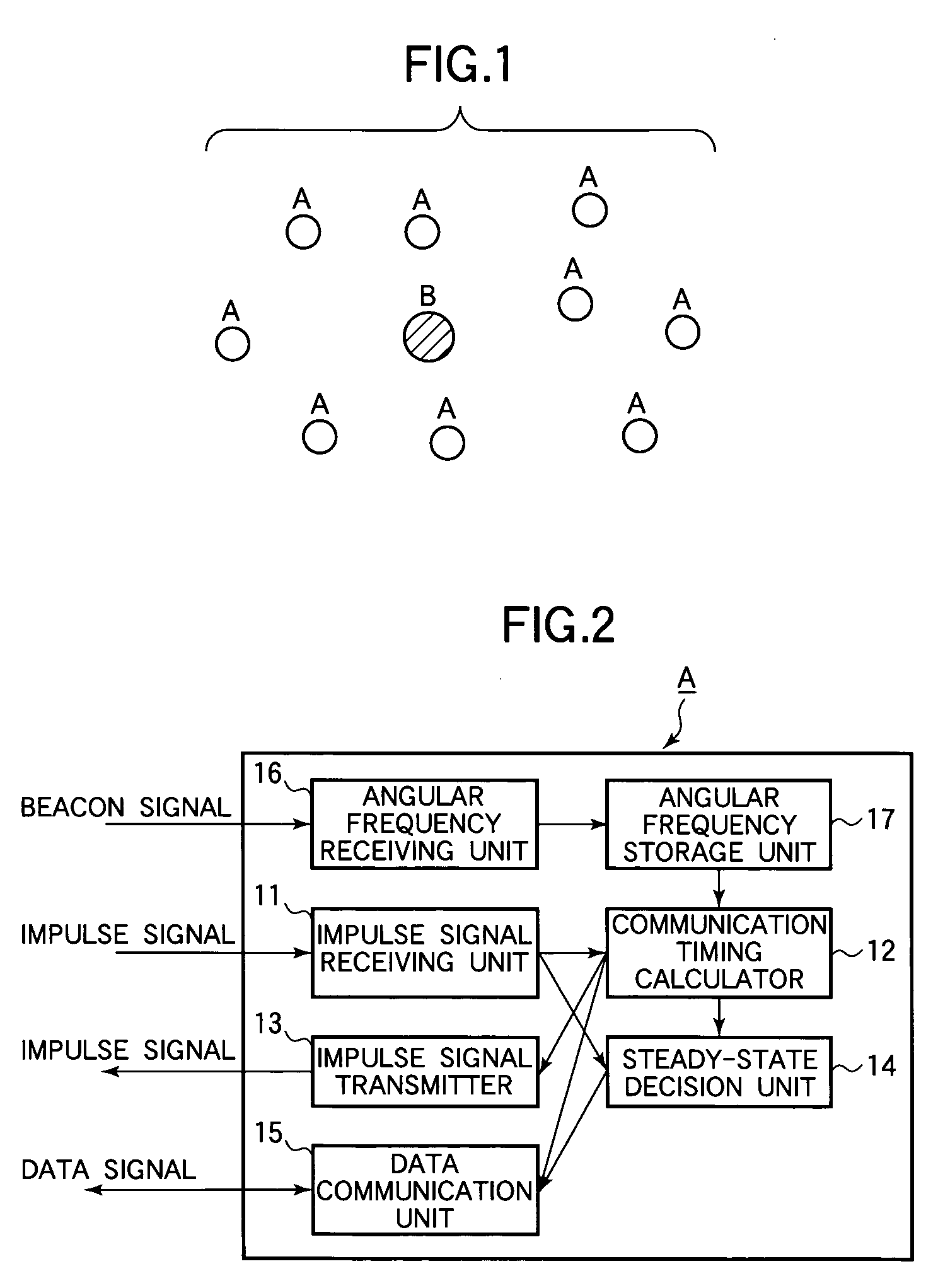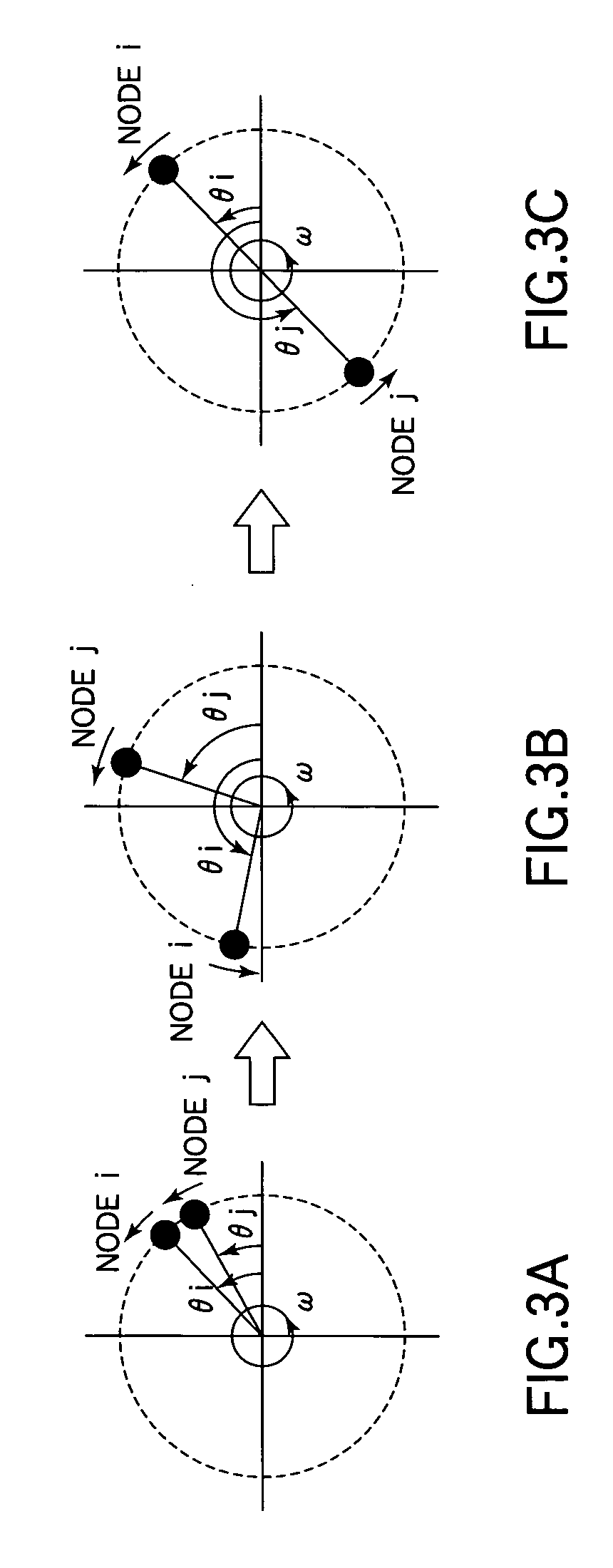Communication timing control method and apparatus, node, and communication system
a communication timing and control method technology, applied in the field of communication timing control methods, communication timing control apparatuses, nodes, and communication systems, can solve the problems of complex process by which time slots are assigned dynamically to nodes, reducing the number of channels that can be used simultaneously, and reducing the number of channels. the effect of signal collision
- Summary
- Abstract
- Description
- Claims
- Application Information
AI Technical Summary
Benefits of technology
Problems solved by technology
Method used
Image
Examples
first embodiment
[0037] Referring to FIG. 2, each general node A in the first embodiment comprises an impulse signal receiving unit 11, a communication timing calculator 12, an impulse signal transmitter 13, a steady-state decision unit 14, a data communication unit 15, an angular frequency receiving unit 16, and an angular frequency storage unit 17. The impulse signal receiving unit 11, communication timing calculator 12, impulse signal transmitter 13, steady-state decision unit 14, angular frequency receiving unit 16, and angular frequency storage unit 17 combine to function as a communication timing control apparatus.
[0038] The impulse signal receiving unit 11 receives impulse signals transmitted by neighboring nodes A. An impulse signal is a signal received as a timing signal, not including any data. The impulse signal may have, for example, a Gaussian waveshape. The neighboring nodes include, for example, all nodes within communication range. The impulse signal receiving unit 11 sends each rec...
second embodiment
[0086] Next a second embodiment of the communication timing control apparatus, communication timing control method, and node and communication system of the present invention will be described with reference to the drawings. The communication system (network) in the second embodiment has general nodes A and a beacon node B; beacon node B is the same as in the first embodiment but the general nodes A are altered. More specifically, the general nodes A lack the angular frequency storage unit (shown in FIG. 2) that stored the recalculated natural angular frequency parameter in the first embodiment, and the functions of the angular frequency receiving unit 16 and communication timing calculator 12 are altered.
[0087] In the second embodiment, the angular frequency receiving unit 16 receives the beacon signal and sends it to the communication timing calculator 12 without performing other operations.
[0088] The communication timing calculator 12 treats the beacon signal received from the ...
third embodiment
[0096] Next a third embodiment of the communication timing control apparatus, communication timing control means, and node and communication system will be described with reference to the drawings.
[0097] The communication system (network) in the third embodiment also has a plurality of general nodes A and a beacon node B. The beacon node B is the same as in the first embodiment, but the general nodes A now have the internal structure shown in FIG. 10.
[0098] The third embodiment differs from the second embodiment in that the beacon signal received from the angular frequency receiving unit 16 is sent not only to the communication timing calculator 12 but also to the steady-state decision unit 14, and also in that the steady-state decision unit 14 uses the beacon signal from the angular frequency receiving unit 16 to decide whether or not the phase relationship between its own node and neighboring nodes is in a stable (steady) state.
[0099] The steady-state decision operations carrie...
PUM
 Login to View More
Login to View More Abstract
Description
Claims
Application Information
 Login to View More
Login to View More - R&D
- Intellectual Property
- Life Sciences
- Materials
- Tech Scout
- Unparalleled Data Quality
- Higher Quality Content
- 60% Fewer Hallucinations
Browse by: Latest US Patents, China's latest patents, Technical Efficacy Thesaurus, Application Domain, Technology Topic, Popular Technical Reports.
© 2025 PatSnap. All rights reserved.Legal|Privacy policy|Modern Slavery Act Transparency Statement|Sitemap|About US| Contact US: help@patsnap.com



